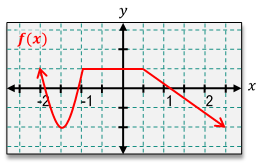Slopes on the graph of the tangent function Graph y = tan x and its derivative together on (−π/2, π/2). Does the graph of the tangent function appear to have a smallest slope? A largest slope? Is the slope ever negative? Give reasons for your answers.
Table of contents
- 0. Functions7h 54m
- Introduction to Functions16m
- Piecewise Functions10m
- Properties of Functions9m
- Common Functions1h 8m
- Transformations5m
- Combining Functions27m
- Exponent rules32m
- Exponential Functions28m
- Logarithmic Functions24m
- Properties of Logarithms36m
- Exponential & Logarithmic Equations35m
- Introduction to Trigonometric Functions38m
- Graphs of Trigonometric Functions44m
- Trigonometric Identities47m
- Inverse Trigonometric Functions48m
- 1. Limits and Continuity2h 2m
- 2. Intro to Derivatives1h 33m
- 3. Techniques of Differentiation3h 18m
- 4. Applications of Derivatives2h 38m
- 5. Graphical Applications of Derivatives6h 2m
- 6. Derivatives of Inverse, Exponential, & Logarithmic Functions2h 37m
- 7. Antiderivatives & Indefinite Integrals1h 26m
- 8. Definite Integrals4h 44m
- 9. Graphical Applications of Integrals2h 27m
- 10. Physics Applications of Integrals 3h 16m
- 11. Integrals of Inverse, Exponential, & Logarithmic Functions2h 31m
- 12. Techniques of Integration7h 41m
- 13. Intro to Differential Equations2h 55m
- 14. Sequences & Series5h 36m
- 15. Power Series2h 19m
- 16. Parametric Equations & Polar Coordinates7h 58m
2. Intro to Derivatives
Basic Graphing of the Derivative
Struggling with Calculus?
Join thousands of students who trust us to help them ace their exams!Watch the first videoMultiple Choice
Based on the graph f(x), describe all points where the derivative f′(x)would have a jump.

A
x=−1.5, x=−1, and x=0.5
B
x=−1 and x=0.5
C
x=−1.5
D
Derivative f′(x) has no jumps
 Verified step by step guidance
Verified step by step guidance1
To determine where the derivative f'(x) has jumps, we need to look for points on the graph of f(x) where there is a sudden change in the slope. These are typically points where the graph has sharp corners or discontinuities.
Examine the graph at x = -1.5. The graph appears smooth and continuous at this point, indicating that there is no jump in the derivative f'(x) here.
Next, examine the graph at x = -1. At this point, the graph has a sharp corner, indicating a sudden change in the slope. This suggests that the derivative f'(x) has a jump at x = -1.
Now, examine the graph at x = 0.5. Similar to x = -1, there is a sharp corner at this point, indicating another sudden change in the slope. Therefore, the derivative f'(x) has a jump at x = 0.5.
Finally, confirm that the graph is smooth and continuous at x = -1.5, as previously noted, ensuring that the derivative f'(x) does not have a jump at this point.

 6:15m
6:15mWatch next
Master Graphing The Derivative with a bite sized video explanation from Patrick
Start learningRelated Videos
Related Practice
Textbook Question
Basic Graphing of the Derivative practice set


